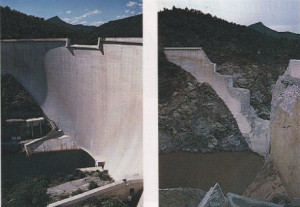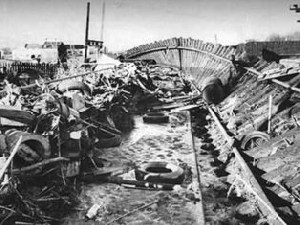The break of the Malpasset Dam, a 60-m high arched structure with a thin diaphragm wall, caused 421 victims and displaced 7,000 more. After several days of torrential rains, this dam set up on the Reyran River north of Fréjus broke at 9:11 pm during its first filling (a critical phase in the life cycle of a dam). A 50 million-m3 deluge of water flooded the Reyran Valley, devastating everything in its path. The city of Fréjus was inundated in just a few minutes by a wave of water and then mud 21 minutes later.
The consequences of this accident were dramatic. Fréjus was totally isolated without services or infrastructure; roads, telephone lines, electricity and water were all down for several days. The RN 7 national highway and railroad were washed away over several hundreds of metres. The Reyran Valley was “denuded” over a 5-km stretch; dwellings, farm buildings and farmland were all destroyed. A 50-cm thick layer of mud covered the local sectors of Reyran, Pavadou, Gare and Arènes.
Given the scope of the disaster and despite the confusion due to a lack of communication resources, emergency response and local solidarity efforts were effectively organised under City Hall supervision.
Works to restore utility networks (communication, water, electric lines, etc.) as well as the roads and railroads got underway. Road and rail traffic was reopened on 10th December. The city would take months to “return to normal”. Temporary prefabricated housing was installed within the city limits to house the displaced population.
Between the State’s financial assistance and private donations received subsequent to the disaster, the Fréjus City Hall paid out more than 100 million francs to help support displaced residents and for rebuilding efforts.
The dam break was caused by an uplift effect due to the presence of a fault combined with a rheological phenomenon of rock mechanics (variation in permeability vs. stress) unknown at the time of construction. No legal blame was assigned to the dam builders by any of the various jurisdictions.
The high quality of the dam’s arch and concrete were well known; the disaster could be ascribed to foundation flaws. This point underscores the importance of geology, fault direction in the subsoil and groundwater patterns when locating a dam, but above all the need for studies indicating potential problems early on in order to introduce proper remediation during construction. As such, sufficient financial resources must also be available to complete a “safe” dam-building project.
A “Permanent Technical Dam Committee” was created to assess projects and oversee execution of any dam structure over 20 m high in France.
New water resources were sought and the Reyran River was channelled.
Download the detailed report in .pdf format (1 Mb)





